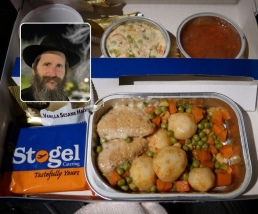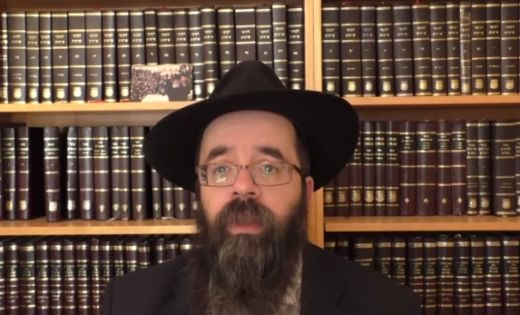Make Money, Not War
In 5752 (1992) the Rebbe Melech HaMoshiach announced that the “Swords into Plowshares” prophecy had begun to be fulfilled. In modern terms, “Swords Into Plowshares” means “reallocating money from weapons towards matters that would increase the sustenance of the citizens of the nation.” • By Prof. Shimon Silman, Beis Moshiach • Full Article
By Prof. Shimon Silman, Beis Moshiach
In the famous sicha of Parshas Mishpatim, 5752, where the Rebbe MHM announced that the Swords into Plowshares (SIP) prophecy of Isaiah had begun to be fulfilled, following the declaration at the UN by the heads of state of the 15 members of the Security Council, one of the aspects of SIP which he mentioned was “reallocating the money that would have been used for weapons towards matters that would increase the sustenance of the citizens of the nation.”
In this paper we will investigate the role of money in the Swords into Plowshares transformation. There are a few different ways in which “it’s about the money.”
Firstly, as the Rebbe MHM said in the sicha, many nations have restructured their budgets so that they are spending less on military development and more on domestic matters that boost their economies. At the RYAL Institute for Moshiach and the Sciences (named for the Rebbe MHM’s brother, Rabbi Yisroel Aryeh Leib Schneerson) we have been researching this and reporting on it over the years on the pages of this magazine.
Seconly, we find that SIP is simply good business! In England, for example, a corporation called Ploughshare Innovations, was established for the sole purpose of transforming British military technologies to peaceful uses and marketing them. They proudly proclaim that their name “reflects long standing ideologies related to converting ‘swords into ploughshares’ and converting items developed for military purposes into civilian applications.”
For example, they have marketed technology for diagnosing Traumatic Brain Injury (TBI). TBI can occur when the head receives an injury that causes back and forth movement of the brain inside the skull such as a fall, traffic accident or sporting injury. TBI is a leading cause of death and disability worldwide. The global incidence of TBI is estimated to be about 800 cases per 100,000 people per year.
The Defense Science and Technology Laboratory (DSTL), a division of the British Defense Ministry, has done a lot of research to diagnose and monitor TBI for soldiers injured in battle. Military operations in Afghanistan have given the DSTL team a lot of experience, knowledge and expertise in TBI. Molecular biology techniques are used to identify novel biomarkers of mild traumatic brain injury from patient blood plasma samples. Ploughshare Innovations has adapted this technology and made it available for use in the general population for rapid diagnosis, prognosis and monitoring of mild to severe traumatic brain injury.
Early Diagnosis of Sepsis
Sepsis is a serious medical condition caused by an overwhelming immune response to a bacterial infection. The chemicals released into the blood to fight the infection trigger widespread inflammation which may result in organ damage. Blood clotting during sepsis reduces blood flow to limbs and internal organs, depriving them of nutrients and oxygen. In severe cases, one or more organs fail. In the worst cases, infection leads to a life-threatening drop in blood pressure and the heart weakens, resulting in septic shock. This can quickly lead to the failure of several organs—lungs, kidneys, and liver—causing death.
Sepsis is difficult to predict, diagnose, and treat. Diagnosed cases of sepsis are exceeding 18 million a year and growing at a rate of 8-10% annually with 1,400 patients dying from sepsis each day in the developed world. New technologies are urgently needed to allow for earlier detection of patients with, or at risk of, sepsis.
Ploughshares Innovations has made available to the medical profession the results of military research on the early detection of Sepsis. A DSTL team has recently reported the identification of 45 biomarkers which give a predictive accuracy of 97.24% of the onset of this life-threatening condition.
The benefits of this are: the identification of sepsis days before clinical symptoms are seen, extension of the therapeutic window for sepsis and significantly reduced patient mortality.
The South China Sea
In the sicha, the Rebbe MHM referred to “peace and unity, cooperation and mutual assistance…among the nations of the world—for the good of all mankind.”
We see that the high degree of economic cooperation initiated in this new SIP era can actually prevent wars from occurring. For example, a few years ago there was high tension in the South China Sea. China was in conflict with the Phillipines over some islands which China claimed belonged to them. There was a military buildup which, it appeared, would lead to a major war. But the analysts predicted, correctly, that there would be no war because China would not want to disrupt the trillions of dollars worth of trade that passed through the South China Sea every year.
Replacing Swords with Plowshares
There are still wars in the world (until the SIP prophecy is completely fulfilled). But as we have pointed out in earlier articles, the good countries, like the US, fight only wars that have to do with uprooting evil from the world—antiterrorist activities, police activity. This brings us to another way in which money plays a role in SIP: using money to reduce the amount of military activity in a war.
In the old days, military money would be spent on producing weapons and supplying them to a nation’s armed forces, to make the war more destructive. What we are now observing is the transformation of this military money into peaceful uses—within war itself!
The US Army and Marine Corps Counterinsurgency Field Manual states that money can be used in place of ammunition, a statement that has been repeated by former US Military General David Petraeus who said that “depending on the situation, money can be more important than ammunition.” Along these lines, the US army has set out guidelines on how to deploy money in its Commander’s Guide to Money as a Weapons System: Tactics, Techniques and Procedures (referred to as MAAWS by the military). What do they mean by this?
They are talking about using money as a “non-kinetic force” that can win the hearts and minds of the local population by stimulating the economy through infrastructure development, job creation, and business stimulation. This is a new approach to fighting the War on Terror—substituting economic aid for military action right in the middle of the war! This brings about a partial cancellation of the war by placating the local population, as opposed to fighting the war militarily in opposition to the local population.
Counterinsurgency (COIN) doctrine, for example, sets out protocol for direct military spending across a wide array of development-style projects, including school-building, infrastructure development (roads, electricity, pipelines, etc.), and agricultural support.
While money is being used to target civilian life with investment, the “other side of the coin” is that it’s being used as an instrument of security and protection for the invading troops, saving lives. Indeed, money is described as a “force multiplier” that can reduce the number of deaths of the international forces in the War on Terror. A correlation was first observed with the monies that US troops distributed to the Iraqi people in the Persian Gulf War in the months after the invasion. These were the confiscated monies and assets from the government of Saddam Hussein, e.g. the bundles of money found hidden in the homes of officials that were “returned” to the population with the aim of providing emergency relief and reconstruction. Evidence at the time indicated that as these monies ran out, the deaths of soldiers rose steeply: in November 2003—when cash payments from Hussein’s funds stopped being made—the number of dead US soldiers rose to 81 (compared to 31 in September 2003, and 42 in October 2003).
The “found” money thus appealed to the US military because it was ready cash that had immediate results, both in reducing military deaths and in fostering relations with the local population. Once it was depleted, the military advocated that a regular source of ready cash be made available. This was realized with the Commander’s Emergency Response Program (CERP) which was introduced in Iraq in 2003 and extended to Afghanistan in 2004. CERP is the largest source of discretionary funding for commanders in the field, but it is only one of a dozen such funding programs, each of which has a different purpose.
In the past war was used as a means for territorial expansion and economic gain. Now economic gain is used as a replacement for weapons, as a means to reduce warfare—what the Rebbe MHM described as ביטול מצב של מלחמה —phasing out the state of warfare.
While the US has taken the lead in this monetary turn, the British Army Field Manual on Countering Insurgency also identifies a central role for money. A section titled “Using money on the battlefield”, focuses on creating opportunities for employment and short-term projects (with an eye to longer term economic security). Money is described as “a much needed economy of force measure” that is at least as effective as physical force. Indeed, the field manual affirms that “careful target selection for the use of money may prove as important as targeting for kinetic operations”.
Finally, guidelines for using money for peaceful purposes on the battlefield have been summarized in one of the U.S. Army manuals in a very clever way (note the acrostic—the first letter of every line spells out WEAPONS):
Work to identify the requirement and appropriate funding authority.
Estimate the cost and ensure funding is available.
Attain required approval(s).
Purchase the goods or services.
Oversee the requirement to receipt or completion.
Notify the appropriate authorized US government (USG) disbursement agency when the goods/services are received or the project is complete.
Secure the appropriate documentation.
No Turning Back
SIP is the fulfillment of a Messianic prophecy. The Messianic Era is a new state of the world. Once it begins, we have essentially a new world. There is no turning back. The world will keep getting better and better until all the Messianic prophecies are fulfilled…May it be immediately—NOW!
*
The magazine can be obtained in stores around Crown Heights. To purchase a subscription, please go to: bmoshiach.org
402
Join ChabadInfo's News Roundup and alerts for the HOTTEST Chabad news and updates!











































